Palliative Aged Care: Safety, Ethical Dilemmas, and 5R Reflection
VerifiedAdded on 2021/06/17
|9
|2451
|31
Report
AI Summary
This report comprehensively addresses key aspects of palliative aged care. It begins by exploring safety and legal responsibilities, emphasizing the importance of evidence-based practices, therapeutic approaches, and adherence to NMBA standards in caring for elderly patients with complex conditions like rheumatoid arthritis and end-stage leukemia. A clinical scenario involving an 89-year-old woman, Mary, is used to illustrate these concepts. The report then delves into ethical dilemmas, particularly concerning confidentiality and information sharing with carers, highlighting the conflict between maintaining patient privacy and involving carers in decision-making. The report references the NMBA code of ethics and registered nurse standards, and discusses how consent and the patient's capacity impact ethical considerations. Finally, the report concludes with a reflection using the 5R model (Reporting, Responding, Relating, Reasoning, Reconstructing), analyzing the nurse's actions, emotional responses, and potential improvements in patient care, with a focus on pain management, therapeutic communication, and holistic care. The report emphasizes the importance of effective training, evidence-based practices, and the need for balancing medical interventions with compassionate care.

Running head: PALLIATIVE AGED CARE
Palliative aged care
Name of the student
University name
Author’s note
Palliative aged care
Name of the student
University name
Author’s note
Paraphrase This Document
Need a fresh take? Get an instant paraphrase of this document with our AI Paraphraser
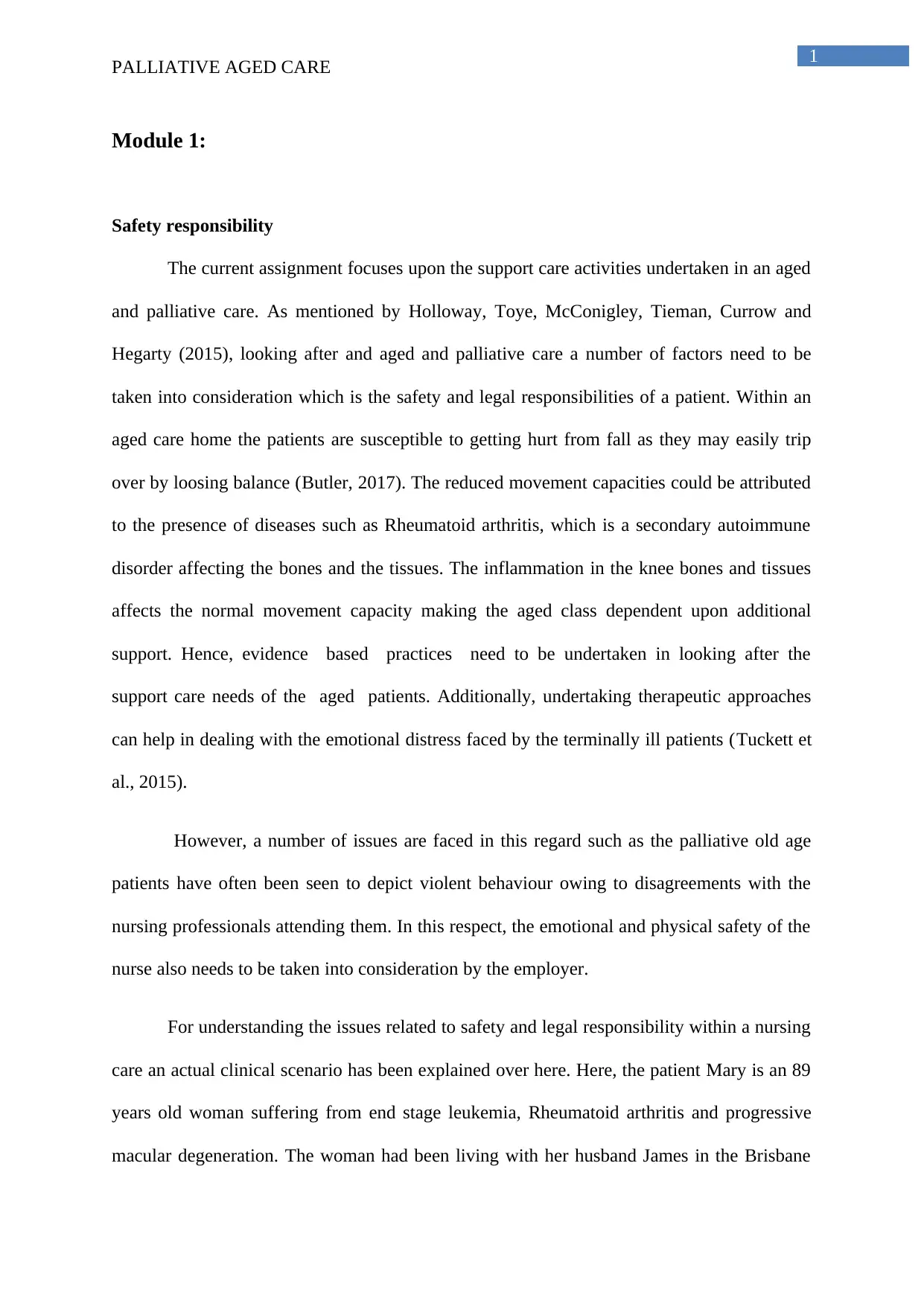
1
PALLIATIVE AGED CARE
Module 1:
Safety responsibility
The current assignment focuses upon the support care activities undertaken in an aged
and palliative care. As mentioned by Holloway, Toye, McConigley, Tieman, Currow and
Hegarty (2015), looking after and aged and palliative care a number of factors need to be
taken into consideration which is the safety and legal responsibilities of a patient. Within an
aged care home the patients are susceptible to getting hurt from fall as they may easily trip
over by loosing balance (Butler, 2017). The reduced movement capacities could be attributed
to the presence of diseases such as Rheumatoid arthritis, which is a secondary autoimmune
disorder affecting the bones and the tissues. The inflammation in the knee bones and tissues
affects the normal movement capacity making the aged class dependent upon additional
support. Hence, evidence based practices need to be undertaken in looking after the
support care needs of the aged patients. Additionally, undertaking therapeutic approaches
can help in dealing with the emotional distress faced by the terminally ill patients (Tuckett et
al., 2015).
However, a number of issues are faced in this regard such as the palliative old age
patients have often been seen to depict violent behaviour owing to disagreements with the
nursing professionals attending them. In this respect, the emotional and physical safety of the
nurse also needs to be taken into consideration by the employer.
For understanding the issues related to safety and legal responsibility within a nursing
care an actual clinical scenario has been explained over here. Here, the patient Mary is an 89
years old woman suffering from end stage leukemia, Rheumatoid arthritis and progressive
macular degeneration. The woman had been living with her husband James in the Brisbane
PALLIATIVE AGED CARE
Module 1:
Safety responsibility
The current assignment focuses upon the support care activities undertaken in an aged
and palliative care. As mentioned by Holloway, Toye, McConigley, Tieman, Currow and
Hegarty (2015), looking after and aged and palliative care a number of factors need to be
taken into consideration which is the safety and legal responsibilities of a patient. Within an
aged care home the patients are susceptible to getting hurt from fall as they may easily trip
over by loosing balance (Butler, 2017). The reduced movement capacities could be attributed
to the presence of diseases such as Rheumatoid arthritis, which is a secondary autoimmune
disorder affecting the bones and the tissues. The inflammation in the knee bones and tissues
affects the normal movement capacity making the aged class dependent upon additional
support. Hence, evidence based practices need to be undertaken in looking after the
support care needs of the aged patients. Additionally, undertaking therapeutic approaches
can help in dealing with the emotional distress faced by the terminally ill patients (Tuckett et
al., 2015).
However, a number of issues are faced in this regard such as the palliative old age
patients have often been seen to depict violent behaviour owing to disagreements with the
nursing professionals attending them. In this respect, the emotional and physical safety of the
nurse also needs to be taken into consideration by the employer.
For understanding the issues related to safety and legal responsibility within a nursing
care an actual clinical scenario has been explained over here. Here, the patient Mary is an 89
years old woman suffering from end stage leukemia, Rheumatoid arthritis and progressive
macular degeneration. The woman had been living with her husband James in the Brisbane
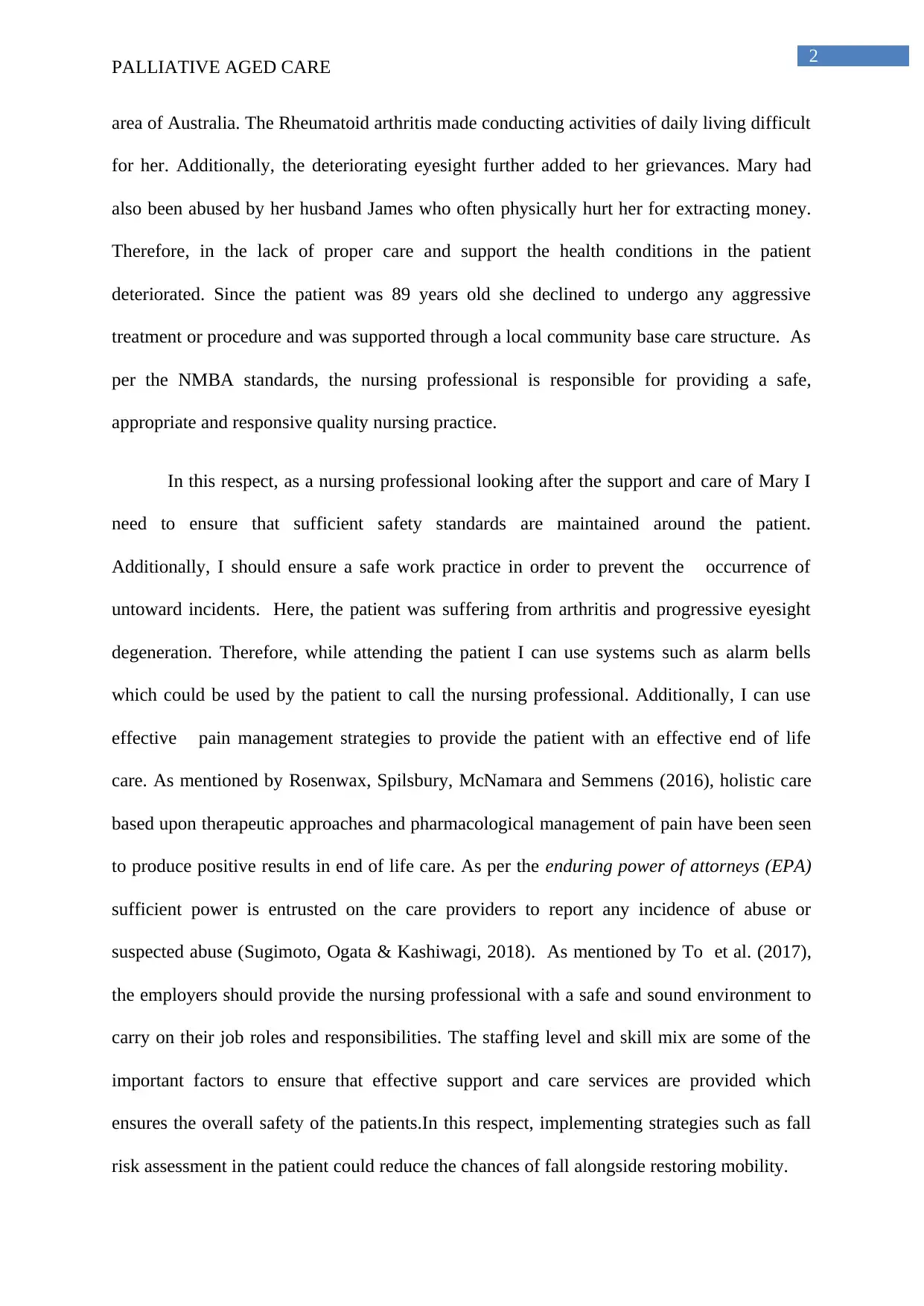
2
PALLIATIVE AGED CARE
area of Australia. The Rheumatoid arthritis made conducting activities of daily living difficult
for her. Additionally, the deteriorating eyesight further added to her grievances. Mary had
also been abused by her husband James who often physically hurt her for extracting money.
Therefore, in the lack of proper care and support the health conditions in the patient
deteriorated. Since the patient was 89 years old she declined to undergo any aggressive
treatment or procedure and was supported through a local community base care structure. As
per the NMBA standards, the nursing professional is responsible for providing a safe,
appropriate and responsive quality nursing practice.
In this respect, as a nursing professional looking after the support and care of Mary I
need to ensure that sufficient safety standards are maintained around the patient.
Additionally, I should ensure a safe work practice in order to prevent the occurrence of
untoward incidents. Here, the patient was suffering from arthritis and progressive eyesight
degeneration. Therefore, while attending the patient I can use systems such as alarm bells
which could be used by the patient to call the nursing professional. Additionally, I can use
effective pain management strategies to provide the patient with an effective end of life
care. As mentioned by Rosenwax, Spilsbury, McNamara and Semmens (2016), holistic care
based upon therapeutic approaches and pharmacological management of pain have been seen
to produce positive results in end of life care. As per the enduring power of attorneys (EPA)
sufficient power is entrusted on the care providers to report any incidence of abuse or
suspected abuse (Sugimoto, Ogata & Kashiwagi, 2018). As mentioned by To et al. (2017),
the employers should provide the nursing professional with a safe and sound environment to
carry on their job roles and responsibilities. The staffing level and skill mix are some of the
important factors to ensure that effective support and care services are provided which
ensures the overall safety of the patients.In this respect, implementing strategies such as fall
risk assessment in the patient could reduce the chances of fall alongside restoring mobility.
PALLIATIVE AGED CARE
area of Australia. The Rheumatoid arthritis made conducting activities of daily living difficult
for her. Additionally, the deteriorating eyesight further added to her grievances. Mary had
also been abused by her husband James who often physically hurt her for extracting money.
Therefore, in the lack of proper care and support the health conditions in the patient
deteriorated. Since the patient was 89 years old she declined to undergo any aggressive
treatment or procedure and was supported through a local community base care structure. As
per the NMBA standards, the nursing professional is responsible for providing a safe,
appropriate and responsive quality nursing practice.
In this respect, as a nursing professional looking after the support and care of Mary I
need to ensure that sufficient safety standards are maintained around the patient.
Additionally, I should ensure a safe work practice in order to prevent the occurrence of
untoward incidents. Here, the patient was suffering from arthritis and progressive eyesight
degeneration. Therefore, while attending the patient I can use systems such as alarm bells
which could be used by the patient to call the nursing professional. Additionally, I can use
effective pain management strategies to provide the patient with an effective end of life
care. As mentioned by Rosenwax, Spilsbury, McNamara and Semmens (2016), holistic care
based upon therapeutic approaches and pharmacological management of pain have been seen
to produce positive results in end of life care. As per the enduring power of attorneys (EPA)
sufficient power is entrusted on the care providers to report any incidence of abuse or
suspected abuse (Sugimoto, Ogata & Kashiwagi, 2018). As mentioned by To et al. (2017),
the employers should provide the nursing professional with a safe and sound environment to
carry on their job roles and responsibilities. The staffing level and skill mix are some of the
important factors to ensure that effective support and care services are provided which
ensures the overall safety of the patients.In this respect, implementing strategies such as fall
risk assessment in the patient could reduce the chances of fall alongside restoring mobility.
⊘ This is a preview!⊘
Do you want full access?
Subscribe today to unlock all pages.

Trusted by 1+ million students worldwide
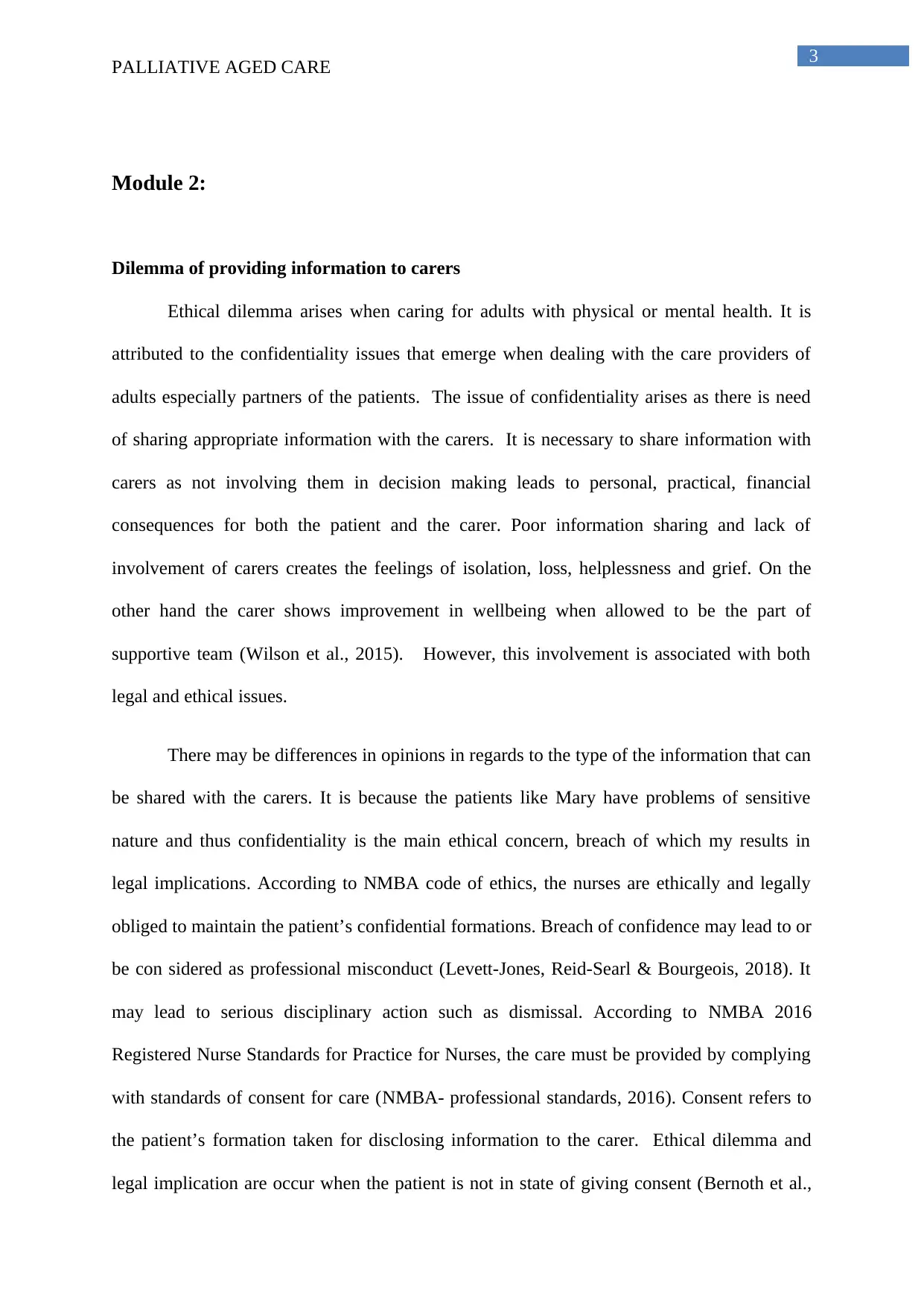
3
PALLIATIVE AGED CARE
Module 2:
Dilemma of providing information to carers
Ethical dilemma arises when caring for adults with physical or mental health. It is
attributed to the confidentiality issues that emerge when dealing with the care providers of
adults especially partners of the patients. The issue of confidentiality arises as there is need
of sharing appropriate information with the carers. It is necessary to share information with
carers as not involving them in decision making leads to personal, practical, financial
consequences for both the patient and the carer. Poor information sharing and lack of
involvement of carers creates the feelings of isolation, loss, helplessness and grief. On the
other hand the carer shows improvement in wellbeing when allowed to be the part of
supportive team (Wilson et al., 2015). However, this involvement is associated with both
legal and ethical issues.
There may be differences in opinions in regards to the type of the information that can
be shared with the carers. It is because the patients like Mary have problems of sensitive
nature and thus confidentiality is the main ethical concern, breach of which my results in
legal implications. According to NMBA code of ethics, the nurses are ethically and legally
obliged to maintain the patient’s confidential formations. Breach of confidence may lead to or
be con sidered as professional misconduct (Levett-Jones, Reid-Searl & Bourgeois, 2018). It
may lead to serious disciplinary action such as dismissal. According to NMBA 2016
Registered Nurse Standards for Practice for Nurses, the care must be provided by complying
with standards of consent for care (NMBA- professional standards, 2016). Consent refers to
the patient’s formation taken for disclosing information to the carer. Ethical dilemma and
legal implication are occur when the patient is not in state of giving consent (Bernoth et al.,
PALLIATIVE AGED CARE
Module 2:
Dilemma of providing information to carers
Ethical dilemma arises when caring for adults with physical or mental health. It is
attributed to the confidentiality issues that emerge when dealing with the care providers of
adults especially partners of the patients. The issue of confidentiality arises as there is need
of sharing appropriate information with the carers. It is necessary to share information with
carers as not involving them in decision making leads to personal, practical, financial
consequences for both the patient and the carer. Poor information sharing and lack of
involvement of carers creates the feelings of isolation, loss, helplessness and grief. On the
other hand the carer shows improvement in wellbeing when allowed to be the part of
supportive team (Wilson et al., 2015). However, this involvement is associated with both
legal and ethical issues.
There may be differences in opinions in regards to the type of the information that can
be shared with the carers. It is because the patients like Mary have problems of sensitive
nature and thus confidentiality is the main ethical concern, breach of which my results in
legal implications. According to NMBA code of ethics, the nurses are ethically and legally
obliged to maintain the patient’s confidential formations. Breach of confidence may lead to or
be con sidered as professional misconduct (Levett-Jones, Reid-Searl & Bourgeois, 2018). It
may lead to serious disciplinary action such as dismissal. According to NMBA 2016
Registered Nurse Standards for Practice for Nurses, the care must be provided by complying
with standards of consent for care (NMBA- professional standards, 2016). Consent refers to
the patient’s formation taken for disclosing information to the carer. Ethical dilemma and
legal implication are occur when the patient is not in state of giving consent (Bernoth et al.,
Paraphrase This Document
Need a fresh take? Get an instant paraphrase of this document with our AI Paraphraser
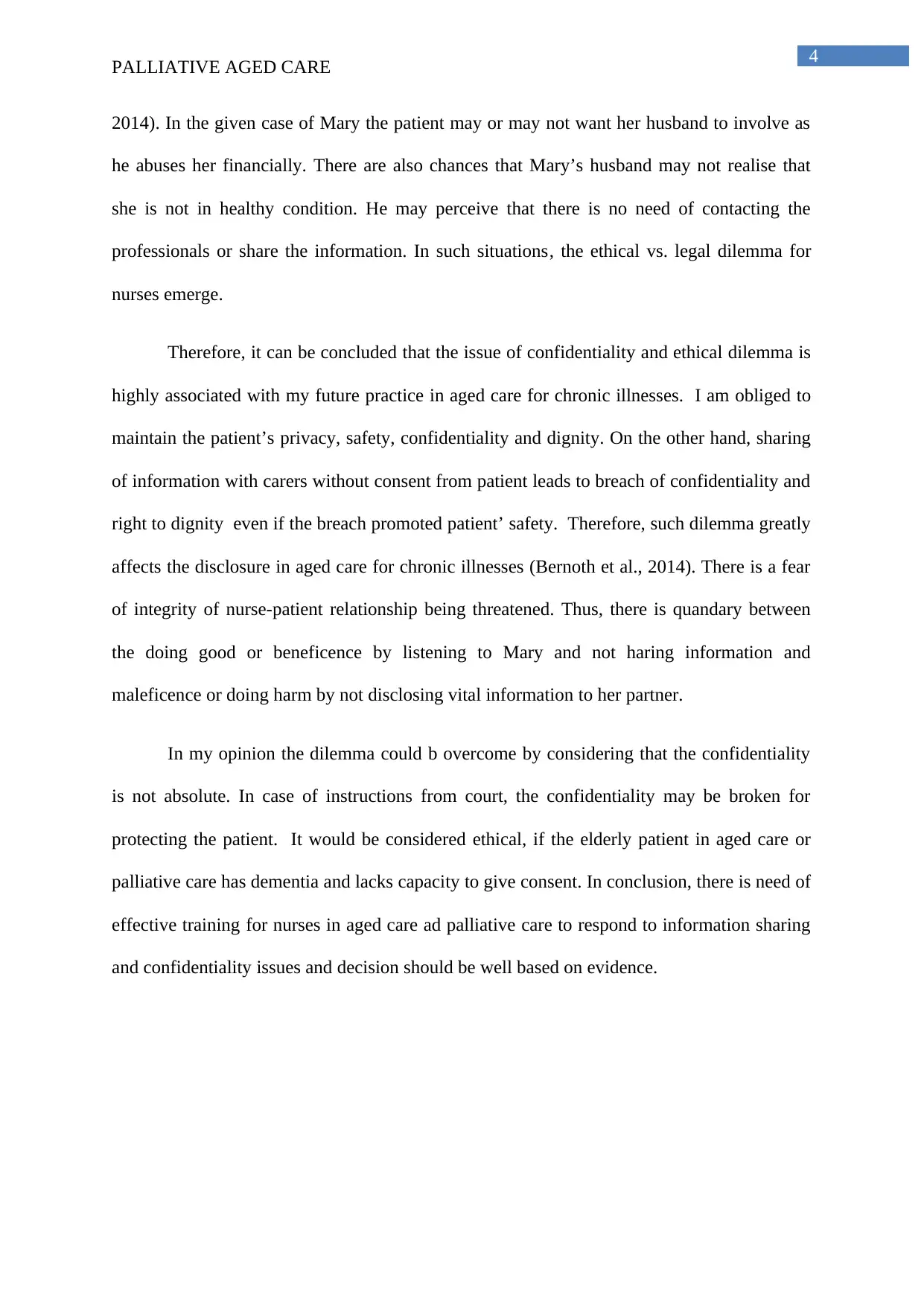
4
PALLIATIVE AGED CARE
2014). In the given case of Mary the patient may or may not want her husband to involve as
he abuses her financially. There are also chances that Mary’s husband may not realise that
she is not in healthy condition. He may perceive that there is no need of contacting the
professionals or share the information. In such situations, the ethical vs. legal dilemma for
nurses emerge.
Therefore, it can be concluded that the issue of confidentiality and ethical dilemma is
highly associated with my future practice in aged care for chronic illnesses. I am obliged to
maintain the patient’s privacy, safety, confidentiality and dignity. On the other hand, sharing
of information with carers without consent from patient leads to breach of confidentiality and
right to dignity even if the breach promoted patient’ safety. Therefore, such dilemma greatly
affects the disclosure in aged care for chronic illnesses (Bernoth et al., 2014). There is a fear
of integrity of nurse-patient relationship being threatened. Thus, there is quandary between
the doing good or beneficence by listening to Mary and not haring information and
maleficence or doing harm by not disclosing vital information to her partner.
In my opinion the dilemma could b overcome by considering that the confidentiality
is not absolute. In case of instructions from court, the confidentiality may be broken for
protecting the patient. It would be considered ethical, if the elderly patient in aged care or
palliative care has dementia and lacks capacity to give consent. In conclusion, there is need of
effective training for nurses in aged care ad palliative care to respond to information sharing
and confidentiality issues and decision should be well based on evidence.
PALLIATIVE AGED CARE
2014). In the given case of Mary the patient may or may not want her husband to involve as
he abuses her financially. There are also chances that Mary’s husband may not realise that
she is not in healthy condition. He may perceive that there is no need of contacting the
professionals or share the information. In such situations, the ethical vs. legal dilemma for
nurses emerge.
Therefore, it can be concluded that the issue of confidentiality and ethical dilemma is
highly associated with my future practice in aged care for chronic illnesses. I am obliged to
maintain the patient’s privacy, safety, confidentiality and dignity. On the other hand, sharing
of information with carers without consent from patient leads to breach of confidentiality and
right to dignity even if the breach promoted patient’ safety. Therefore, such dilemma greatly
affects the disclosure in aged care for chronic illnesses (Bernoth et al., 2014). There is a fear
of integrity of nurse-patient relationship being threatened. Thus, there is quandary between
the doing good or beneficence by listening to Mary and not haring information and
maleficence or doing harm by not disclosing vital information to her partner.
In my opinion the dilemma could b overcome by considering that the confidentiality
is not absolute. In case of instructions from court, the confidentiality may be broken for
protecting the patient. It would be considered ethical, if the elderly patient in aged care or
palliative care has dementia and lacks capacity to give consent. In conclusion, there is need of
effective training for nurses in aged care ad palliative care to respond to information sharing
and confidentiality issues and decision should be well based on evidence.
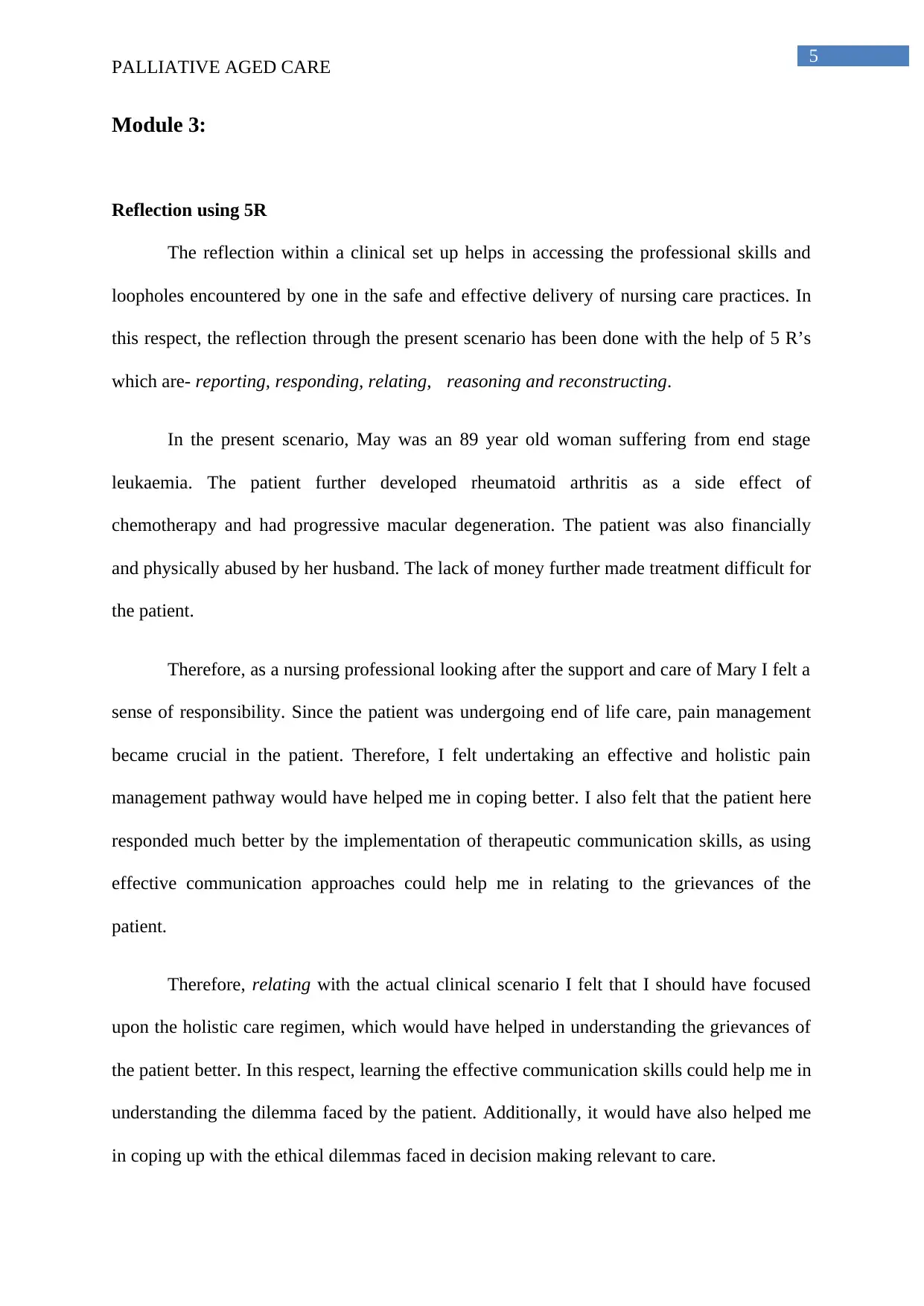
5
PALLIATIVE AGED CARE
Module 3:
Reflection using 5R
The reflection within a clinical set up helps in accessing the professional skills and
loopholes encountered by one in the safe and effective delivery of nursing care practices. In
this respect, the reflection through the present scenario has been done with the help of 5 R’s
which are- reporting, responding, relating, reasoning and reconstructing.
In the present scenario, May was an 89 year old woman suffering from end stage
leukaemia. The patient further developed rheumatoid arthritis as a side effect of
chemotherapy and had progressive macular degeneration. The patient was also financially
and physically abused by her husband. The lack of money further made treatment difficult for
the patient.
Therefore, as a nursing professional looking after the support and care of Mary I felt a
sense of responsibility. Since the patient was undergoing end of life care, pain management
became crucial in the patient. Therefore, I felt undertaking an effective and holistic pain
management pathway would have helped me in coping better. I also felt that the patient here
responded much better by the implementation of therapeutic communication skills, as using
effective communication approaches could help me in relating to the grievances of the
patient.
Therefore, relating with the actual clinical scenario I felt that I should have focused
upon the holistic care regimen, which would have helped in understanding the grievances of
the patient better. In this respect, learning the effective communication skills could help me in
understanding the dilemma faced by the patient. Additionally, it would have also helped me
in coping up with the ethical dilemmas faced in decision making relevant to care.
PALLIATIVE AGED CARE
Module 3:
Reflection using 5R
The reflection within a clinical set up helps in accessing the professional skills and
loopholes encountered by one in the safe and effective delivery of nursing care practices. In
this respect, the reflection through the present scenario has been done with the help of 5 R’s
which are- reporting, responding, relating, reasoning and reconstructing.
In the present scenario, May was an 89 year old woman suffering from end stage
leukaemia. The patient further developed rheumatoid arthritis as a side effect of
chemotherapy and had progressive macular degeneration. The patient was also financially
and physically abused by her husband. The lack of money further made treatment difficult for
the patient.
Therefore, as a nursing professional looking after the support and care of Mary I felt a
sense of responsibility. Since the patient was undergoing end of life care, pain management
became crucial in the patient. Therefore, I felt undertaking an effective and holistic pain
management pathway would have helped me in coping better. I also felt that the patient here
responded much better by the implementation of therapeutic communication skills, as using
effective communication approaches could help me in relating to the grievances of the
patient.
Therefore, relating with the actual clinical scenario I felt that I should have focused
upon the holistic care regimen, which would have helped in understanding the grievances of
the patient better. In this respect, learning the effective communication skills could help me in
understanding the dilemma faced by the patient. Additionally, it would have also helped me
in coping up with the ethical dilemmas faced in decision making relevant to care.
⊘ This is a preview!⊘
Do you want full access?
Subscribe today to unlock all pages.

Trusted by 1+ million students worldwide
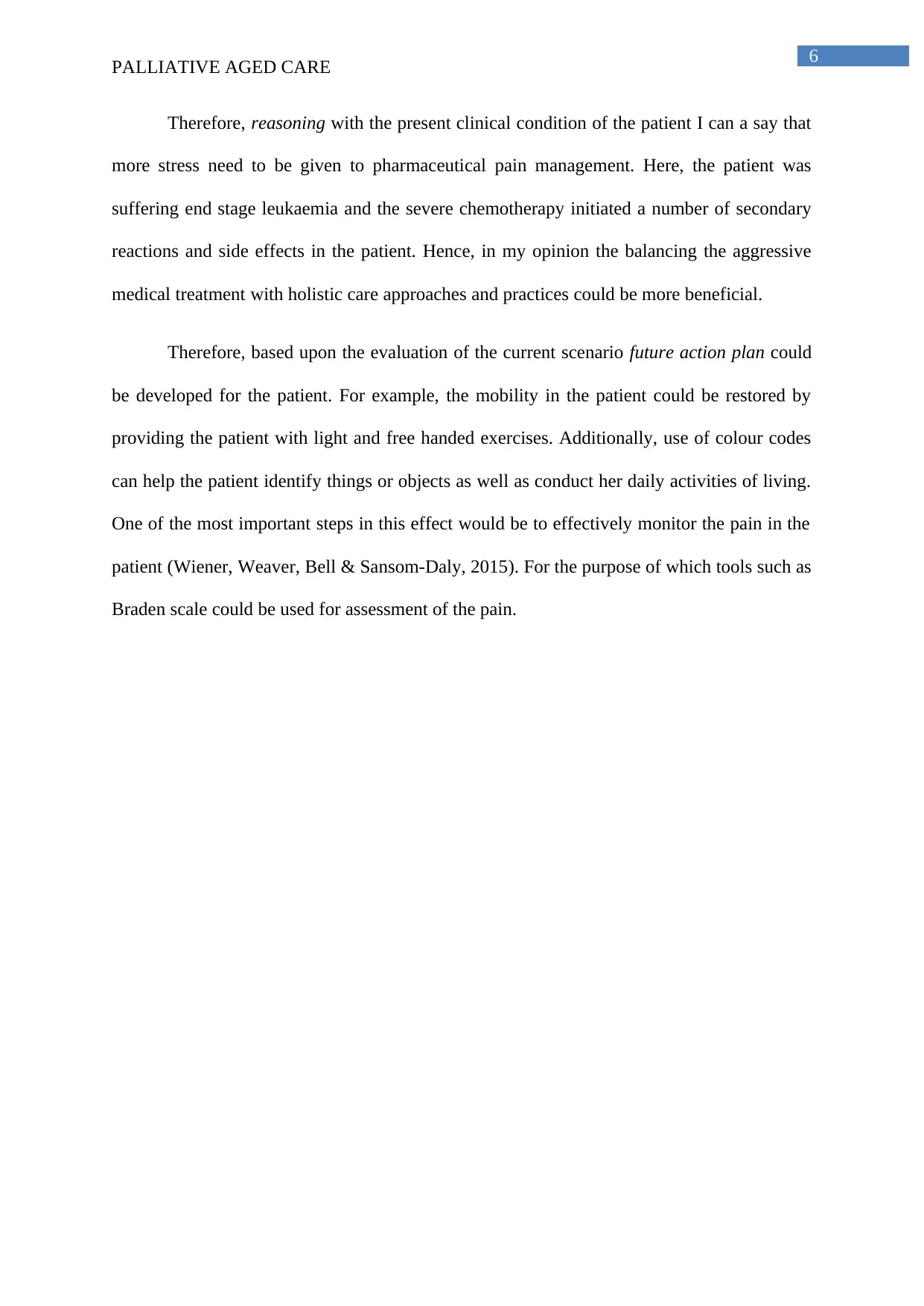
6
PALLIATIVE AGED CARE
Therefore, reasoning with the present clinical condition of the patient I can a say that
more stress need to be given to pharmaceutical pain management. Here, the patient was
suffering end stage leukaemia and the severe chemotherapy initiated a number of secondary
reactions and side effects in the patient. Hence, in my opinion the balancing the aggressive
medical treatment with holistic care approaches and practices could be more beneficial.
Therefore, based upon the evaluation of the current scenario future action plan could
be developed for the patient. For example, the mobility in the patient could be restored by
providing the patient with light and free handed exercises. Additionally, use of colour codes
can help the patient identify things or objects as well as conduct her daily activities of living.
One of the most important steps in this effect would be to effectively monitor the pain in the
patient (Wiener, Weaver, Bell & Sansom-Daly, 2015). For the purpose of which tools such as
Braden scale could be used for assessment of the pain.
PALLIATIVE AGED CARE
Therefore, reasoning with the present clinical condition of the patient I can a say that
more stress need to be given to pharmaceutical pain management. Here, the patient was
suffering end stage leukaemia and the severe chemotherapy initiated a number of secondary
reactions and side effects in the patient. Hence, in my opinion the balancing the aggressive
medical treatment with holistic care approaches and practices could be more beneficial.
Therefore, based upon the evaluation of the current scenario future action plan could
be developed for the patient. For example, the mobility in the patient could be restored by
providing the patient with light and free handed exercises. Additionally, use of colour codes
can help the patient identify things or objects as well as conduct her daily activities of living.
One of the most important steps in this effect would be to effectively monitor the pain in the
patient (Wiener, Weaver, Bell & Sansom-Daly, 2015). For the purpose of which tools such as
Braden scale could be used for assessment of the pain.
Paraphrase This Document
Need a fresh take? Get an instant paraphrase of this document with our AI Paraphraser
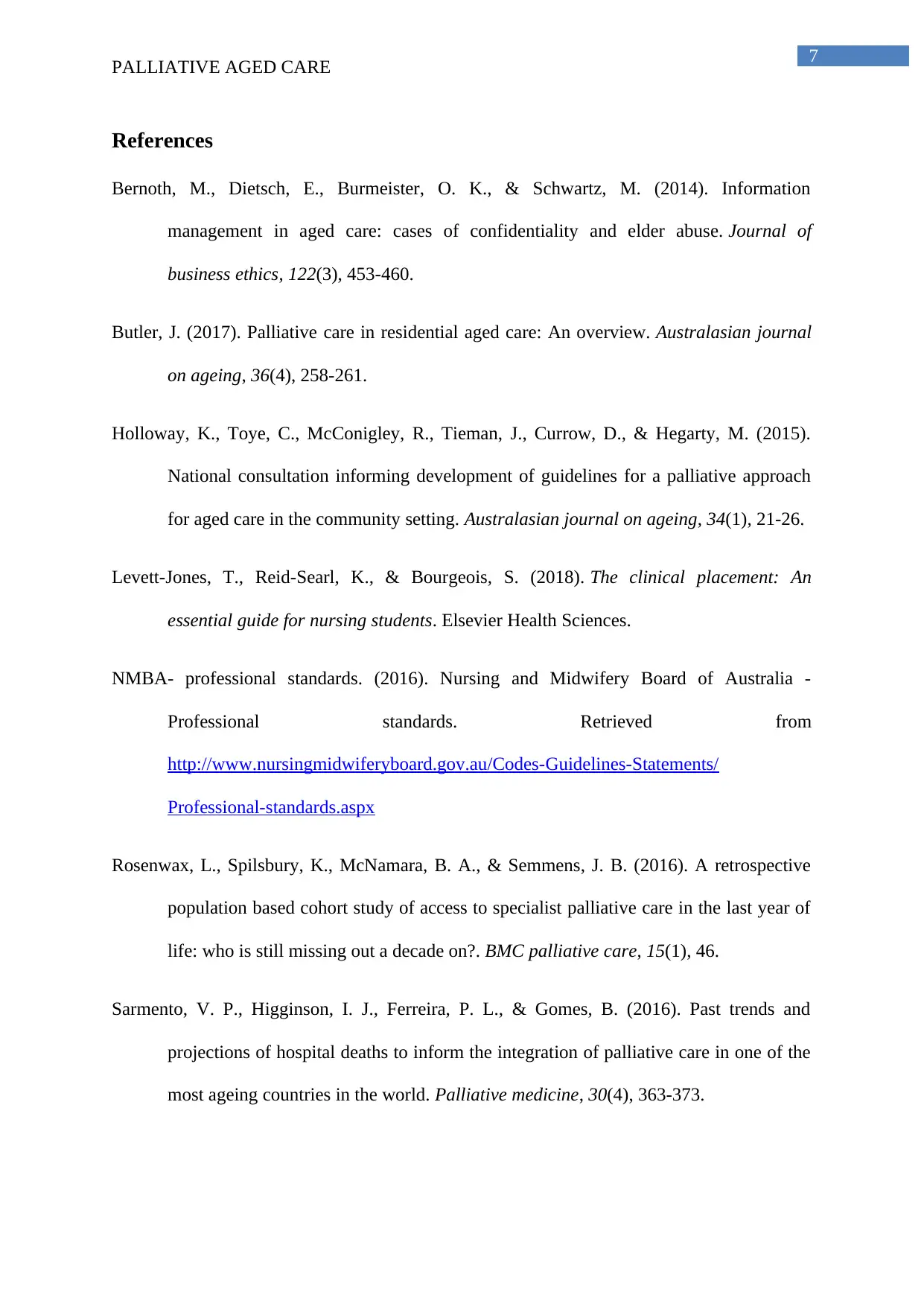
7
PALLIATIVE AGED CARE
References
Bernoth, M., Dietsch, E., Burmeister, O. K., & Schwartz, M. (2014). Information
management in aged care: cases of confidentiality and elder abuse. Journal of
business ethics, 122(3), 453-460.
Butler, J. (2017). Palliative care in residential aged care: An overview. Australasian journal
on ageing, 36(4), 258-261.
Holloway, K., Toye, C., McConigley, R., Tieman, J., Currow, D., & Hegarty, M. (2015).
National consultation informing development of guidelines for a palliative approach
for aged care in the community setting. Australasian journal on ageing, 34(1), 21-26.
Levett-Jones, T., Reid-Searl, K., & Bourgeois, S. (2018). The clinical placement: An
essential guide for nursing students. Elsevier Health Sciences.
NMBA- professional standards. (2016). Nursing and Midwifery Board of Australia -
Professional standards. Retrieved from
http://www.nursingmidwiferyboard.gov.au/Codes-Guidelines-Statements/
Professional-standards.aspx
Rosenwax, L., Spilsbury, K., McNamara, B. A., & Semmens, J. B. (2016). A retrospective
population based cohort study of access to specialist palliative care in the last year of
life: who is still missing out a decade on?. BMC palliative care, 15(1), 46.
Sarmento, V. P., Higginson, I. J., Ferreira, P. L., & Gomes, B. (2016). Past trends and
projections of hospital deaths to inform the integration of palliative care in one of the
most ageing countries in the world. Palliative medicine, 30(4), 363-373.
PALLIATIVE AGED CARE
References
Bernoth, M., Dietsch, E., Burmeister, O. K., & Schwartz, M. (2014). Information
management in aged care: cases of confidentiality and elder abuse. Journal of
business ethics, 122(3), 453-460.
Butler, J. (2017). Palliative care in residential aged care: An overview. Australasian journal
on ageing, 36(4), 258-261.
Holloway, K., Toye, C., McConigley, R., Tieman, J., Currow, D., & Hegarty, M. (2015).
National consultation informing development of guidelines for a palliative approach
for aged care in the community setting. Australasian journal on ageing, 34(1), 21-26.
Levett-Jones, T., Reid-Searl, K., & Bourgeois, S. (2018). The clinical placement: An
essential guide for nursing students. Elsevier Health Sciences.
NMBA- professional standards. (2016). Nursing and Midwifery Board of Australia -
Professional standards. Retrieved from
http://www.nursingmidwiferyboard.gov.au/Codes-Guidelines-Statements/
Professional-standards.aspx
Rosenwax, L., Spilsbury, K., McNamara, B. A., & Semmens, J. B. (2016). A retrospective
population based cohort study of access to specialist palliative care in the last year of
life: who is still missing out a decade on?. BMC palliative care, 15(1), 46.
Sarmento, V. P., Higginson, I. J., Ferreira, P. L., & Gomes, B. (2016). Past trends and
projections of hospital deaths to inform the integration of palliative care in one of the
most ageing countries in the world. Palliative medicine, 30(4), 363-373.
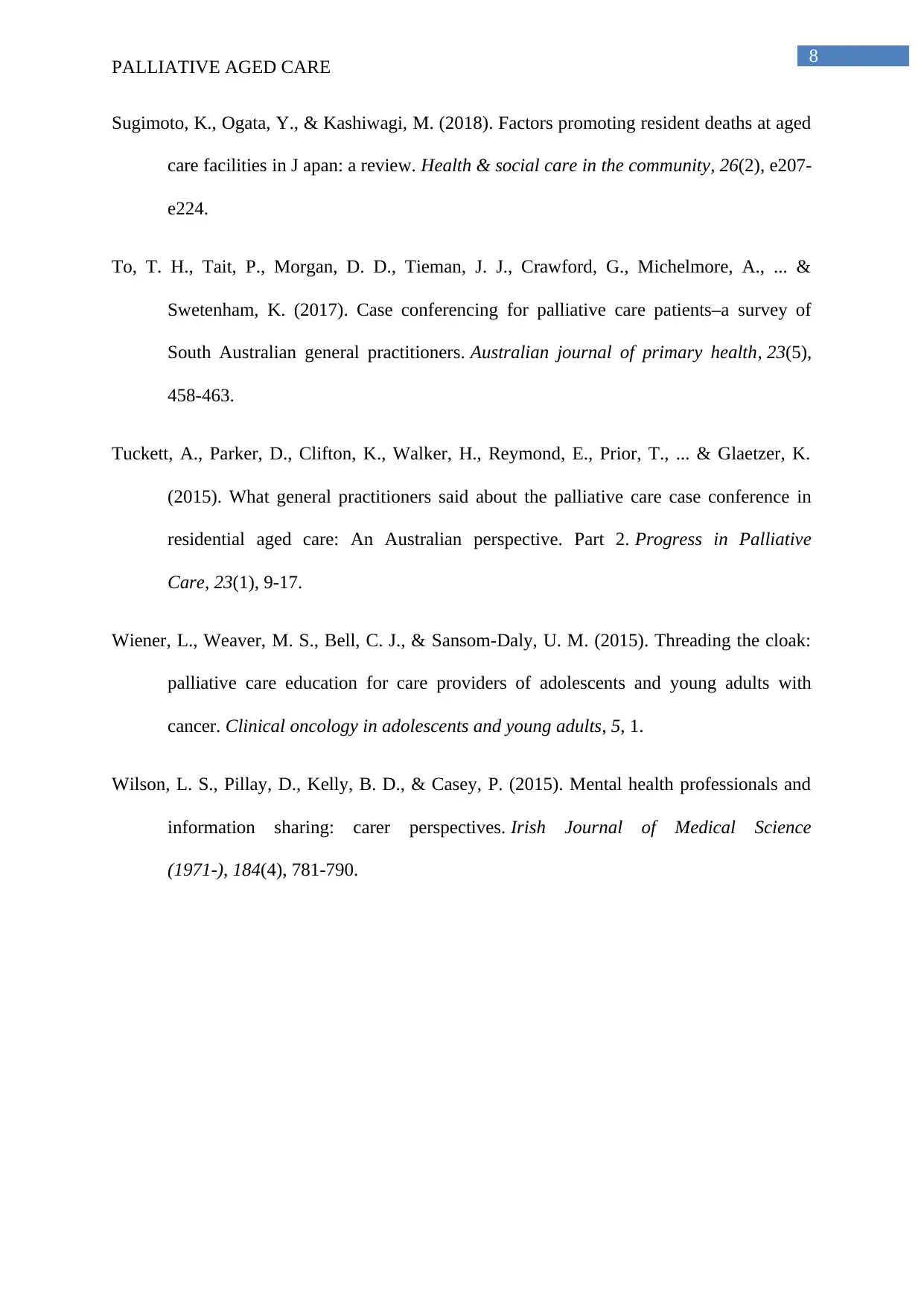
8
PALLIATIVE AGED CARE
Sugimoto, K., Ogata, Y., & Kashiwagi, M. (2018). Factors promoting resident deaths at aged
care facilities in J apan: a review. Health & social care in the community, 26(2), e207-
e224.
To, T. H., Tait, P., Morgan, D. D., Tieman, J. J., Crawford, G., Michelmore, A., ... &
Swetenham, K. (2017). Case conferencing for palliative care patients–a survey of
South Australian general practitioners. Australian journal of primary health, 23(5),
458-463.
Tuckett, A., Parker, D., Clifton, K., Walker, H., Reymond, E., Prior, T., ... & Glaetzer, K.
(2015). What general practitioners said about the palliative care case conference in
residential aged care: An Australian perspective. Part 2. Progress in Palliative
Care, 23(1), 9-17.
Wiener, L., Weaver, M. S., Bell, C. J., & Sansom-Daly, U. M. (2015). Threading the cloak:
palliative care education for care providers of adolescents and young adults with
cancer. Clinical oncology in adolescents and young adults, 5, 1.
Wilson, L. S., Pillay, D., Kelly, B. D., & Casey, P. (2015). Mental health professionals and
information sharing: carer perspectives. Irish Journal of Medical Science
(1971-), 184(4), 781-790.
PALLIATIVE AGED CARE
Sugimoto, K., Ogata, Y., & Kashiwagi, M. (2018). Factors promoting resident deaths at aged
care facilities in J apan: a review. Health & social care in the community, 26(2), e207-
e224.
To, T. H., Tait, P., Morgan, D. D., Tieman, J. J., Crawford, G., Michelmore, A., ... &
Swetenham, K. (2017). Case conferencing for palliative care patients–a survey of
South Australian general practitioners. Australian journal of primary health, 23(5),
458-463.
Tuckett, A., Parker, D., Clifton, K., Walker, H., Reymond, E., Prior, T., ... & Glaetzer, K.
(2015). What general practitioners said about the palliative care case conference in
residential aged care: An Australian perspective. Part 2. Progress in Palliative
Care, 23(1), 9-17.
Wiener, L., Weaver, M. S., Bell, C. J., & Sansom-Daly, U. M. (2015). Threading the cloak:
palliative care education for care providers of adolescents and young adults with
cancer. Clinical oncology in adolescents and young adults, 5, 1.
Wilson, L. S., Pillay, D., Kelly, B. D., & Casey, P. (2015). Mental health professionals and
information sharing: carer perspectives. Irish Journal of Medical Science
(1971-), 184(4), 781-790.
⊘ This is a preview!⊘
Do you want full access?
Subscribe today to unlock all pages.

Trusted by 1+ million students worldwide
1 out of 9
Related Documents
Your All-in-One AI-Powered Toolkit for Academic Success.
+13062052269
info@desklib.com
Available 24*7 on WhatsApp / Email
![[object Object]](/_next/static/media/star-bottom.7253800d.svg)
Unlock your academic potential
Copyright © 2020–2025 A2Z Services. All Rights Reserved. Developed and managed by ZUCOL.



